Physio Fiona White complied this set of stretches for riders on the RACV Great Victorian Bike Ride and they’re great to follow any ride.
Before we start, here are a few simple stretching guidelines to follow:
1. Focus on muscles that are tight in your own body. We are all different and our bodies react differently to exercise. It’s not rocket science, tight muscles need more time!
2. Hold each stretch for 20–30 seconds. This allows the muscles to better relax, resulting in longer-term benefits. A quick five-second stretch feels great but the effect doesn’t last, so take your time and your body will thank you!
3. Don’t overstretch. Stretches should feel moderately comfortable and should not cause pain. If stretches are causing you to wince, try spending more time on that stretch with less intensity. A very strong 5–10 second stretch is more likely to cause micro-tears in your muscles than to improve your flexibility. See guideline 4 below and, if pain persists, seek advice from a physiotherapist or medical practitioner.
4. Ease into it. Throughout a 20–30 second stretch, you will feel the muscles relaxing, allowing you to gradually move further into the stretch. Now read the first word again: ease. Notice I didn’t say bounce? Bouncing is a pointless waste of good stretching time after a ride; it may look impressive, but it does very little to relax and stretch your joints and muscles, and can cause injury. Consider yourself warned!
5. Stretch both sides, not just the one that’s stiff or sore.
6. Breathe. Aside from being a vital component of living, breathing also helps you relax into a stretch. Try long slow exhales as your ease further into your stretches. It will not only help to reduce muscle tension, but deep breathing can also improve oxygen supply to your muscles and decrease your stress levels.
The intensity and duration of your ride should guide how comprehensively you need to stretch. That is, a 30-minute gentle ride doesn’t require the same amount of stretching as a two-three-hour hills session. There are many valuable stretches that bike riders use to help reduce the risk of injury and improve cycling performance. However, I have listed six ‘non-negotiables’ that should be completed after every ride. All should be held for 20-30 seconds.
An added benefit of these exercises is that they are great for people who spend a lot of time sitting each day. Cycling posture is remarkably similar to sitting in an office chair (think curved spine, rounded shoulders, flexed knees and hip, head protruding forwards). So, try setting a reminder to do one or two of these stretches each hour to break up the work day and improve your posture and flexibility!
Please note, this is general information and should not take precedence over specific advice given to you by your own healthcare professional in relation to your specific needs or injuries. These stretches are safe and appropriate for most people, but please take care and listen to your own body.
Calf stretch
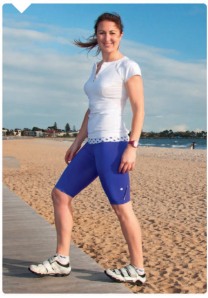 If you’ve ever been on a busy roadie training circuit on a Saturday morning you’ll realise that bike riders use their calves, a lot! Try either of these calf stretches.
If you’ve ever been on a busy roadie training circuit on a Saturday morning you’ll realise that bike riders use their calves, a lot! Try either of these calf stretches.
Option 1: Stand at arm’s length from a wall (as per the main picture on page 60). Place hands on the wall at shoulder height, step the right leg back behind you as far as you can, pressing the right heel to the ground. Your left knee can bend, but ensure your right stays straight. As you move your weight slowly forward, you should feel a stretch in the middle of your right calf. After holding for 20–30 seconds, bend your right knee slightly while keeping the heel on the floor. You should feel the stretch lower down towards the Achilles. Repeat on the other side.
Option 2: Stand on the edge of a step, with the heel of your left foot off the edge. Gradually shift your weight towards the left leg and allow the heel to drop below the level of the step. You should feel a gentle stretch in the middle of your left calf. After 20–30 seconds, slightly bend the left knee, feeling a stretch lower down towards the Achilles. Repeat on the other side.
Quadriceps
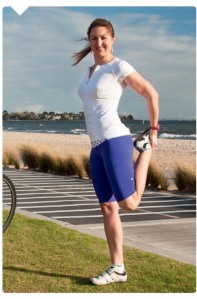 Your quadriceps help to lift up and straighten your knee when bike riding. They attach across the front of the hip and knee, and run down the front of your thigh. Try this stretch lying on one side or standing.
Your quadriceps help to lift up and straighten your knee when bike riding. They attach across the front of the hip and knee, and run down the front of your thigh. Try this stretch lying on one side or standing.
Bend knee, bring heel to buttock and hold ankle with the hand on the same side. Keep knees together or slightly pull the stretched knee behind the other to add a hip flexor stretch. Repeat on the other side.
Hamstrings
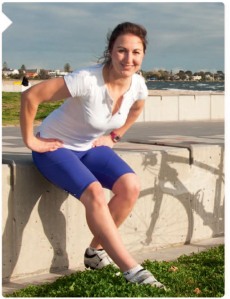 These muscles work in synergy with our quadriceps, and often end up very tight in bike riders due to the amount of time we spend with our knees flexed. As they attach to the pelvis, tight hamstrings commonly occur in conjunction with low back pain, so it is important to do these correctly.
These muscles work in synergy with our quadriceps, and often end up very tight in bike riders due to the amount of time we spend with our knees flexed. As they attach to the pelvis, tight hamstrings commonly occur in conjunction with low back pain, so it is important to do these correctly.
Sit tall on the edge of a chair. Bend your left knee, and straighten the right out in front allowing both feet to rest on the floor. Keeping your back straight or slightly arched, bend forward, moving your navel towards your knee. Do not slouch forward or pull back on the toes of the right foot, as both of these actions target the nerves instead of the hamstring muscles. Repeat on the other side.
Chest expansion
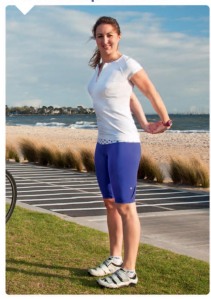 Bike riding causes us to spend a lot of time curved forward at the upper and mid spine, similar to slouching. This stretch is the reverse of this posture, and feels great after a long ride.
Bike riding causes us to spend a lot of time curved forward at the upper and mid spine, similar to slouching. This stretch is the reverse of this posture, and feels great after a long ride.
Interlock hands behind your back with palms facing towards your back. Straighten elbows, and lift hands up, extending through the chest. You should feel a stretch through the chest, shoulders and arms, and possibly in the thoracic (middle/upper) spine. Take care not to lean forward.
Side trunk/ITB stretch
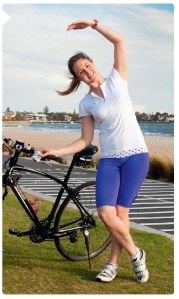 The ITB (ilio-tibial band), which runs down the side of the thigh, is a common cause of discomfort. While this stretch helps to maintain the flexibility of your ITB you may also need to try some other more specific variations. Are you good at Twister? If so, follow these instructions; if not, just copy the photo!
The ITB (ilio-tibial band), which runs down the side of the thigh, is a common cause of discomfort. While this stretch helps to maintain the flexibility of your ITB you may also need to try some other more specific variations. Are you good at Twister? If so, follow these instructions; if not, just copy the photo!
Standing with your left leg crossed behind your right, raise your left arm and reach sideways over your head towards your right side, stretching the side of your left knee, thigh, hip and trunk. Your weight should mostly rest on the left foot, using your right leg mainly for balance. Repeat on the other side.
Neck stretch
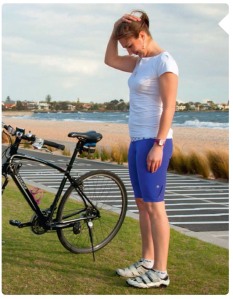 As we lean forward towards the handlebars, we are forced to extend our necks to look up and around us. Neck tightness is a common complaint for bike riders, but this stretch (in addition to adjusting your technique and bike set-up) can help.
As we lean forward towards the handlebars, we are forced to extend our necks to look up and around us. Neck tightness is a common complaint for bike riders, but this stretch (in addition to adjusting your technique and bike set-up) can help.
Start sitting down, with your back supported in a chair, or standing with good posture. Tuck your chin towards your chest, feeling a gentle stretch behind your neck and possibly between your shoulder blades. If this does not produce much of a stretching sensation, gently pull your head further forward into position.
Fiona White is principal Physiotherapist at Own Body www.ownbody.com.au
Ride On content is editorially independent, but is supported financially by members of Bicycle Network. If you enjoy our articles and want to support the future publication of high-quality content, please consider helping out by becoming a member.

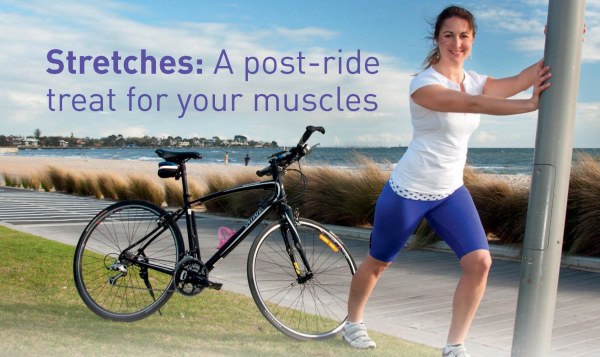
Many thanks, this is very helpful for an amateur/recreational rider septuagenarian rider who is about to go on a cycling holiday in Puglia near the end of next month.
Half your luck! Sounds great. Have a fabulous time.
Great tips! As a frequent rider I tend to relegate stretching although I am aware of its importance & my body definitely needs it!!! …will try to adopt the routine… I promise!
Thanks for this.
Look after your – IT BAND
I recently learnt the hard way to do pre-ride stretches. For that big IT Band that goes from the outer knee to the hip.
Cause =-I had my bike seat YOO LOW for ONE ride. Damaged the IT Band and I was out for 6 weeks.
Needed to spend $$ physio, weeks of major complicated stretches ice, massage.
Cheeers